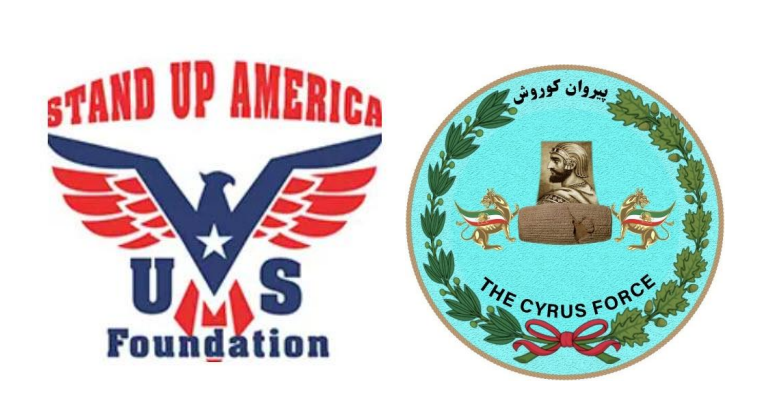By MG Paul E Vallely, US Army (Ret) and Sohrab ChamanAra and John Naimi, Co-Directors of Cyrus Force Iran
November 2, 2025
Forty-seven years have passed since the revolution, and roughly ten million Iranians now live abroad; many have acquired new citizenships, and second- and third-generation communities have arisen. Several million more travel regularly between Iran and other countries for work or family reasons. This ten-million-strong population resembles an “Iran of the Diaspora” and displays every aspect of Iranian life outside the country.
An overwhelming majority of this population agrees on one fundamental point: this clerical regime must be removed from Iran. In the early years of the regime’s rule, theft, executions, imprisonment, and the strangling of the press were carried out mainly in secret and behind closed doors; but beginning with Mahmoud Ahmadinejad’s presidency, theft and plunder began to take place openly and at unprecedented speed.
Ahmadinejad — whose views were closer to the Supreme Leader than those of some others — for years diverted public attention with distractions and gossip, until finally a video was shown in parliament revealing conversations between Brother Larijani and Judge Mortazavi; a scene that made clear arrangements for dividing “shares” and introduced Babak Zanjani.
At that time, Babak Zanjani had defrauded the oil company of tens of billions of dollars; it is alleged that Ahmadinejad, together with Judge Mortazavi and Mojtaba Khamenei, had invested some twenty billion dollars in Venezuela, and that Ahmadinejad himself had spent one billion dollars as a “contribution” toward investments in Nicaragua. In this diaspora, you will find everything a country should have: from mosques, mourning gatherings, and religious circles to cultural institutions, festivals, Ashura commemorations, and charitable food-distribution rituals.
Above all, there are political centers and organizations — groups of ten to a hundred people, parties, congresses, associations, institutes, and think tanks — with the difference that if there is one “National Front” inside Iran, there are hundreds of National Fronts abroad, all with pictures of Mossadegh. If there is a Tudeh Party inside Iran, the diaspora shows a hundred varieties of “Tudeh-like” parties. If monarchists exist in Iran, tens of monarchist, constitutionalist, royalist, and Pahlavi groups are active outside it. The same variety exists among the Mujahedin, republicans, secularists, supporters of laïcité, reformists, and principalities.
Despite all these disagreements, they are united on one issue: the overthrow of the clerical regime — unless, of course, an individual’s income depends on that predatory regime. In every speech, conference, march, or radio/television debate, the central topics are theft, plunder, treason, executions, imprisonment, mandatory hijab, brutality, national destruction, poverty, and environmental devastation.
But on the questions “What should be done?” and “What is the roadmap?” there is almost complete silence; as if there is no tomorrow for Iran. In a historical conclusion we can assign much of the responsibility to the two dictatorships that have ruled Iran over the past hundred years; yet there are also people — even with university degrees — who blame Iran’s ninety million people for their “understanding” or “lack of insight.” More foolish still are those who pin their hopes on foreign invasion and shamelessly support external aggression in order to gain a position or financial aid.
The purpose of this text is to conclude. But first one must ask all these political scientists, literati, “waiting monarchists” or “aspiring presidents,” and especially spokespeople, national security advisers and diplomats a single question: very well — suppose everything you say and all your efforts bring about the intended result, namely the overthrow of the clerical regime — what will you do the day after the overthrow? Do you want to expel these ninety million Iranians from Iran and bring other Iranians to replace them? Certainly not. So, what will you do with the people living in Iran? Do you not mean to change the country’s structure? How can that be accomplished?
Several times in modern Iranian history — 120 years ago, 47 years ago — revolutions have changed the ruling regime, but what did they do then? They wrote a constitution in a constituent assembly, which remains the present framework of the country’s structure. Therefore, the goal must be changing the constitution—not merely changing the regime—because altering the constitution will alter the structure of power and, consequently, the regime itself will change.
Detractors say this regime will never permit a change of constitution and that the regime must first be toppled by military attack or mass uprising and then the constitution changed. This idea was tested several times — in the Green Movement, in the November 2019 protests (Aban 98) and in the Mahsa Amini uprising — and showed that the regime is not only willing to massacre several thousand people, but if necessary is prepared to kill millions.
Accordingly, we arrive at a simple, practical conclusion: changing the constitution in several stages — together with concrete civil actions — is the only way to save Iran and guarantee the security of other countries. Other slogans were once correct and effective, but today only one slogan makes sense:
Change the Constitution — the Roadmap to Forming a Constituent Assembly and Saving Iran


